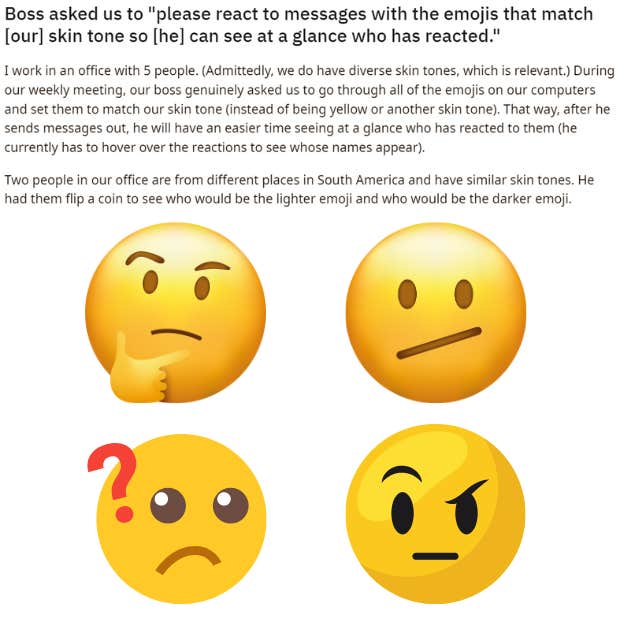Boss Demands That Employees React To Messages With Emojis That Match Their Skin Tone So He Can Tell Them Apart
He asked two South American employees to flip a coin to see what skin tone to use.
 PeopleImages.com, Yuri A / Shutterstock
PeopleImages.com, Yuri A / Shutterstock With so many diverse people in the workplace, it’s important that we acknowledge each person’s identity and culture. The need to allow the space for people to be their authentic selves is becoming of the utmost importance as employees demand respect and dignity.
Knowing where to draw the line between making everyone feel welcome and comfortable, and coming off as insensitive and cringey, can be tough for some.
One person’s boss had an unusual request for his staff that quickly spiraled into what many might feel was an inappropriate interaction.
A worker took to the r/mildlyinfuriating subreddit to voice their concerns over a manager’s attempt to make identifying each employee’s reactions to messages.
 Photo: Reddit
Photo: Reddit
The worker started their post by saying there are only five people working in the office. “Admittedly, we do have diverse skin tones, which is relevant,” they added.
In a weekly meeting, the manager asked each of them to set the emojis they use in reacting to messages to a color that matched their own skin tones. The employees were asked to stop using yellow and white emojis that don’t look like them.
The boss' reasoning was that when sending messages, he could see who reacted at a glance instead of hovering over the reactions to see who had interacted with the communication. Most employees were likely willing to do this, since it was not that big an ask, but what came next was downright offensive.
When two employees from separate South American countries had similar skin tones, the boss told them to flip a coin to see who the lighter emoji would be and who would be the darker one.
The story ended there, but readers were quick to point out that the man’s unorthodox way of handling diversity in the office reminded them of the character, Michael Scott, from the hit show, "The Office." The first comment, upvoted over 8,000 times simply read, “Michael Scott? Is that you?”
Like Michael Scott, one person acknowledged that while the manager’s intentions may have been good, he went about it all wrong. They said, “This is 100% a Scott moment. He's trying to make it better, but in a horrible way.”
Supporting diversity at work requires well-thought-out and intentional actions.
The manager’s attempt at labeling employees using their skin colors started down the wrong track immediately. He wasn’t doing something he thought would improve workplace culture or make people feel accepted. Instead, he was making the change for his own convenience — because he just could not bear to take a couple of seconds to hover over reactions.
Not only did he possibly, but unintentionally, force people into identifying themselves publicly, but he also told two people that their racial or ethnic identity could be whittled down to the flip of a coin. That in itself seems demeaning and belittling, something that was surely not the intention.
There are some better ways to foster diversity and inclusion at work:
Be aware of unconscious bias.
Forcing employees to self-identify, whether it makes them uncomfortable or not, can subject them to both conscious and unconscious bias. Though it might be of little concern to you personally, it’s important to recognize that not having to worry about how you may be perceived due to your race or ethnicity is a privilege that everyone is not afforded.
 Photo: Fizkes / Shutterstock
Photo: Fizkes / Shutterstock
Create employee resource groups.
Employee resource groups (ERGs) are formed to support members of marginalized demographics that need support. Having these within your organization shows that you understand that different groups of people have their own unique needs and struggles.
Manage bias in policies and practices.
Review your company’s practices and policies to make sure that nothing that might inadvertently exclude any particular group of people is removed or updated appropriately. Diversity, Equity, and Inclusion is about seeing the whole picture and implementing processes and procedures that work for every person in the organization.
Sometimes, you might not have all of the answers when it comes to dealing with diverse populations. In those times, it’s important to reach out to someone who does.
Trying to fumble your way through inclusivity can easily turn into a trainwreck, like the one detailed here, costing your reputation and potentially big bucks if your behavior is deemed discriminatory.
NyRee Ausler is a writer and author from Seattle, Washington. She covers issues navigating the workplace using the experience garnered over two decades of working in Human Resources and Diversity, Equity, and Inclusion.

